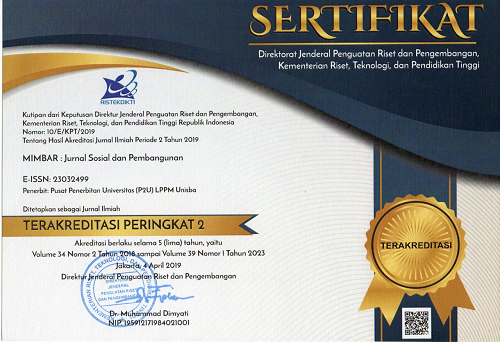Women Farmer’s Participation And Empowerment To Support Family Food Self- Sufficiency
Abstract
Agricultural development is currently prioritizing on the technical aspects and pays less attention to human factors which resulting in low empowerment of farmers. The patriarchal system which still prevails in rural areas causing the involvement of women in the decision-making process is still very low, so as the importance of empowering women in rural areas in order to make them more confident about themselves and are able to formulate and convey the problems efficiently. The research objectives are (1) to analyze the level of women farmers’ empowerment, and (2) to analyze factors affecting the level of participation and empowerment of women farmers. Data were processed using quantitative analysis supported by qualitative analysis. The results obtained the level of women farmer’s empowerment in medium category, the activities of Women Farmers Group (KWT) categories of low in making decisions, increasing the additional income and distribute production, the medium category, namely access to information and regulate family food consumptions, and high category that aspect of utilizing their yards. Factors that mostly affect the empowerment of women farmers are a long time to cultivate the farm yard, the level of income, cosmopolitan level, motivation level, intensity of interaction within the groups, the development of technical capabilities, the intensity of the assistance, government policy support, social environment conduciveness, interpersonal, group, behavior in using media, planning, income utilization, and monitoring and evaluation activities.
Keywords
Full Text:
PDFReferences
Aminah S, Sumardjo, Lubis DP, Susanto D. 2015. Factor affecting peasants’ empowerment in West Halmahera District- a case study from Indonesia. J.Agriculture and Rural Development in the Tropics and Subtropics. 116 (1): 1-15.
Elizabeth R. 2007. Peran ganda wanita tani dalam mencapai ketahanan pangan rumah tangga di perdesaan. J.Penelitian Agro Ekonomi. 25 (2): 126-135 [diunduh 9 Nov 2014]. Tersedia pada: http://www.puslittan.bogor.net/ berkas_PDF/IPTEK/2008/Nomor-1/05-Roosganda.pdf
Erwiantono, Amanah S, Asngari PS, Kinseng RA. 2013. Partisipasi masyarakat dalam pengelolaan areal perlindungan laut berbasis masyarakat di Kabupaten Administrasi Kepulauan Seribu DKI Jakarta. J.Sosial Ekonomi Kelautan dan Perikanan. 8 (2): 201-216.
Hadiyanto. 2009. Desain pendekatan komunikasi partisipatif dalam pemberdayaan peternak domba rakyat. J.Media Peternakan. 32 (2): 145-154.
Hubeis AVS. 2010. Pemberdayaan Perempuan dari Masa ke Masa. Bogor (ID): IPB Press.
Moleong LJ. 1991. Metodologi Penelitian Kualitatif. Bandung (ID): Remaja Posdakarya.
Nurdin. 2011. Antisipasi perubahan iklim untuk keberlanjutan ketahanan pangan. J.Dialog Kebijakan Publik Kementerian Komunikasi dan Informatika. 4 (2011): 21-31.
Purwanto R, Sulaeman A, Watimena GA. 2012. Sejarah dan Perkembangan Revolusi Hijau, Revolusi Bioteknologi dan Revolusi Hijau Lestari. Bogor (ID): IPB Press.
Rinawati R. 2004. Partisipasi wanita dalam pembangunan. J. Mimbar. 20(3):387-405.
Rinawati R, Fardiah D, Kurniadi O. 2007. Keterlibatan perempuan dalam pengambilan keputusan pada perencanaan pembangunan. J. Mimbar. 23(2):157-177.
Sumardjo. 1999. Kemandirian sebagai indikator kesiapan petani menghadapi era globalisasi. J Mimbar Sosek. 12(1):1-15.
Supriadi WC. 2004. Perempuan dan Kesetaraan di dalam Keluarga. J Mimbar. 20(3): 263-273.
DOI: https://doi.org/10.29313/mimbar.v32i2.1846
Refbacks
- There are currently no refbacks.
MIMBAR : Jurnal Sosial dan Pembangunan is licensed under Creative Commons Attribution-NonCommercial-ShareAlike 4.0 International License.















